Abstract
This study utilizes a zero-dimensional, constant-pressure, perfectly stirred reactor (PSR) model within the Cantera framework to examine the combustion characteristics of hydrogen, methane, methanol, and propane, both singly and in hydrogen-enriched mixtures. The impact of the equivalence ratio (ϕ = 0.75, 1.0, 1.5), fuel composition, and residence duration on temperature increase, heat release, ignition delay, and emissions (NOx and CO2) is methodically assessed. The simulations are performed under steady-state settings to emulate the ignition and flame propagation processes within pre-chambers and primary combustion zones of internal combustion engines. The results demonstrate that hydrogen significantly improves combustion reactivity, decreasing ignition delay and increasing peak flame temperature, especially at short residence times. The incorporation of hydrogen into hydrocarbon fuels, such as methane and methanol, enhances ignition speed, improves thermal efficiency, and stabilizes lean combustion. Nevertheless, elevated hydrogen concentrations result in increased NOx emissions, particularly at stoichiometric equivalence ratios, due to higher flame temperatures. The examination of fuel mixtures at varying hydrogen concentrations (10–50% by mole) indicates that thermal performance is optimal under stoichiometric settings and diminishes in both fuel-lean and fuel-rich environments. A thermodynamic model was created utilizing classical combustion theory to validate the heat release estimates based on Cantera. The model computes the heat release per unit volume (MJ/m3) by utilizing stoichiometric oxygen demand, nitrogen dilution, fuel mole fraction, and higher heating values (HHVs). The thermodynamic estimates—3.61 MJ/m3 for H2–CH3OH, 3.43 MJ/m3 for H2–CH4, and 3.35 MJ/m3 for H2–C3H8—exhibit strong concordance with the Cantera results (2.82–3.02 MJ), thereby validating the physical consistency of the numerical methodology. This comparison substantiates the Cantera model for the precise simulation of hydrogen-blended combustion, endorsing its use in the design and development of advanced low-emission engines.
1. Introduction
Hydrogen, due to its unique combustion characteristics, holds great potential for future energy systems and is environmentally friendly. It is suitable for advanced combustion strategies, such as Homogeneous Charge Compression Ignition (HCCI) and Reactive Controlled Compression Ignition (RCCI), which aim to enhance engine performance and reduce emissions. However, hydrogen-fueled engines face challenges related to pre-combustion processes, knocking, and backfiring [1,2,3]. To address these, scientists have designed combustion chambers, swirling technologies, and resistant materials. Developing hydrogen infrastructure and supply chains is crucial for broader applications of hydrogen-fueled engines [4,5]. This study enhances previous research by conducting an extensive sensitivity analysis of Bi-fuel blends—hydrogen, propane, methane, and methanol—utilizing a sophisticated Cantera-based computational model. It builds upon prior research by combining hydrogen’s quick combustion efficiency, methanol’s cooling properties, and methane’s energy stability to enhance emissions and energy production. The study primarily examines deficiencies in the comprehension of NOx and CO2 production mechanisms within Bi-fuel systems, investigating the influence of equivalency ratios and fuel proportions [6,7,8].
The primary goal is to determine optimal blend ratios for clean, efficient, and adaptable combustion systems, particularly in areas with limited hydrogen infrastructure.
2. Literature Review
Jingyun Sun (2023) [9] investigated hydrogen–methanol mixtures with varying methane proportions, highlighting NOx behavior, the dual functions of hydrogen and methanol, and their synergistic impacts on emission mitigation and reactivity.
Dimitriou (2018) [10,11] examined hydrogen–diesel engines, demonstrating diminished emissions at low loads but encountering issues such as pre-ignition at medium loads. This highlights the importance of EGR and water injection technology for NOx mitigation.
Li (2023) [12] emphasized the relationship between flame temperature and NOx emissions, illustrating the necessity of modifying hydrogen equivalence ratios for emission regulation.
Dam (2024) [13] introduced a dynamic hydrogen combustion model demonstrating enhanced torque and efficiency while tackling cooling and injection issues arising from elevated combustion temperatures.
Verhelst (2023) [14] and Wallnerb (2009) [15] investigated hydrogen–methane mixtures, revealing trade-offs among NOx emissions, energy density, and efficiency, where hydrogen enhances efficiency but elevates NOx emissions.
Molina (2023) [16] examined hydrogen and methanol mixtures, highlighting dilution methods for NOx mitigation and the significance of injection strategies to optimize combustion stability and efficiency.
S.K.V. (2014) [17] illustrated that regulated hydrogen ratios improve brake thermal efficiency and reduce CO emissions; NOx issues were observed at elevated hydrogen levels.
Huang (2024) [18] investigated injector design and timing in hydrogen combustion, revealing that optimum designs enhance efficiency and diminish NOx emissions while mitigating pre-ignition and knock concerns.
Bakar (2022) [19] evaluated hydrogen–diesel dual-fuel engines, demonstrating enhancements in efficiency while underscoring difficulties in NOx management and combustion stability in low circumstances.
Keromnes (2013) [20] analyzed the combustion of hydrogen and methane, highlighting hydrogen’s reduced NOx emissions in rich mixtures and methane’s distinctive combustion dynamics attributed to its superior volumetric energy density.
This study significantly enhances and expands the current literature by providing a comprehensive numerical analysis of the combustion properties of hydrogen–methane and hydrogen–methanol blends, focusing on their thermal dynamics, emission behavior, and practical applications in Bi-fuel systems [21,22,23,24]. This study examines the interactions among these fuels, focusing on how their distinct characteristics—such as hydrogen’s strong reactivity, methane’s moderate energy density, and methanol’s cooling effects—impact combustion stability and pollutant generation. The study performs a comprehensive sensitivity analysis of equivalency ratios to determine optimal operating conditions that balance thermal efficiency and emissions management, fulfilling a crucial requirement for design optimization in advanced combustion systems. Additionally, it provides a comprehensive analysis of pollutant indicators, such as NOx emissions, across three different fuel blend combinations. This elucidates how variations in blend composition affect pollutant generation, facilitating the creation of cleaner and more efficient engine designs. This work not only corroborates prior findings but also addresses gaps in the literature by providing practical insights into the design and operation of sustainable multi-fuel combustion technology.
3. Model and Methods
Figure 1 This model utilizes Cantera’s Ideal Gas Reactor (David G. Goodwin, 2023) [25] framework to simulate a perfectly stirred reactor (PSR) and examine the combustion dynamics under constant-pressure, steady-state conditions. This study investigates the effect of various equivalence ratios (ϕ = 0.75, 1.0, 1.5) on the combustion of pure hydrogen (H2) and methane (CH4), calculating key thermochemical parameters such as temperature increase, heat release rate, and NOx emissions. The device systematically decreases the residence time to evaluate the response of fuel–air mixtures during abbreviated combustion periods, simulating high-speed or lean-extinction conditions.
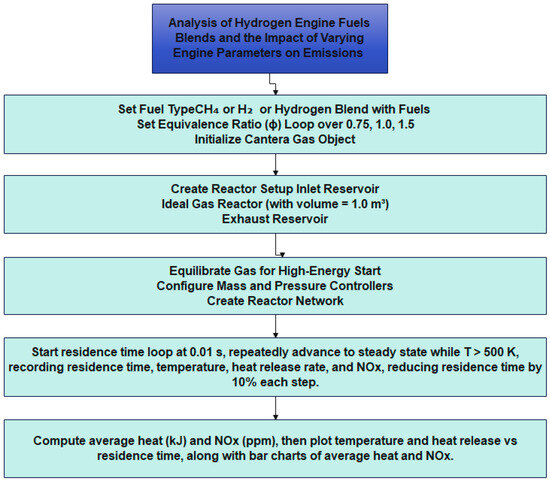
Figure 1.
An overview of the hydrogen combustion models examined in this study.
This concept, however, is immensely pertinent to the advancement of internal combustion engines [26,27,28]. It encapsulates the fundamental dynamics of small, reactive volumes, rendering it especially appropriate for simulating pre-chambers and stratified ignition zones in contemporary engines. These regions typically function under stable pressure conditions, and their ignition dynamics are essential for effective flame propagation and knock reduction [29,30,31].
The model is a crucial tool for fuel research and emissions analysis. It facilitates the direct comparison of alternative fuels and mixes (Kiverin, 2023) [32] and (Wang) [33], which is particularly significant given the increasing transition towards hydrogen. Hydrogen mixtures with methane or other hydrocarbons can be assessed using this framework, facilitating the quantification of their effects on ignition delay, combustion structure, and pollutant generation. The model enables the calibration of ignition timing in spark-ignition engines by determining the appropriate equivalence ratios and residence periods for various mixtures.
This reactor-based simulation offers a practical framework for understanding the impact of fuel chemistry, mixture strength, and residence time on combustion quality, a crucial factor in the transition to cleaner, hydrogen-integrated engine technology.
4. Results
4.1. Comparative Analysis of Hydrogen and Methane Combustion: The Impact of Equivalence Ratio and Fuel Characteristics
Figure 2, Figure 3 and Figure 4 below illustrate the temperature increase and volumetric heat release rate of methane (CH4) and hydrogen (H2) at different equivalence ratios (ϕ = 0.75, 1.0, 1.5) as a function of the reactor residence time, employing a perfectly stirred reactor (PSR) model under constant pressure conditions. For both fuels, the temperature increases with residence time due to improved reaction completeness; nevertheless, hydrogen consistently attains higher flame temperatures at all equivalence ratios, indicating its superior reactivity and energy density. At ϕ = 1.0 (stoichiometric), the temperature reaches its apex, whereas lean (ϕ = 0.75) and rich (ϕ = 1.5) combinations have relatively lower peak temperatures, owing to restricted fuel or oxygen supplies. Heat release rate trends exhibit early peaks during brief residence durations, diminishing over time due to fuel depletion and product accumulation. Hydrogen demonstrates markedly more excellent heat release rates than methane, owing to its accelerated kinetics and superior lower heating value. The results underscore hydrogen’s benefits for high-efficiency, rapid combustion, positioning it as a viable alternative for next-generation internal combustion engines and pre-chamber ignition systems where ignition velocity and thermal performance are paramount.

Figure 2.
Temperature increases for methane combustion under different equivalence ratios.
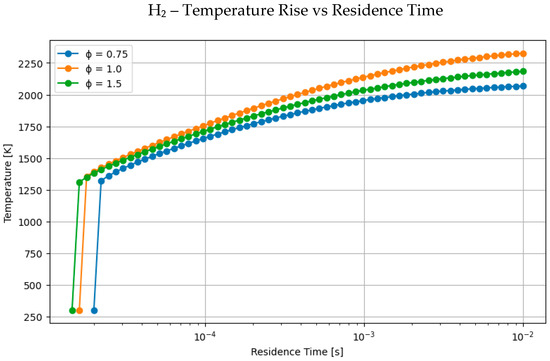
Figure 3.
Temperature increases for hydrogen combustion under different equivalence ratios.
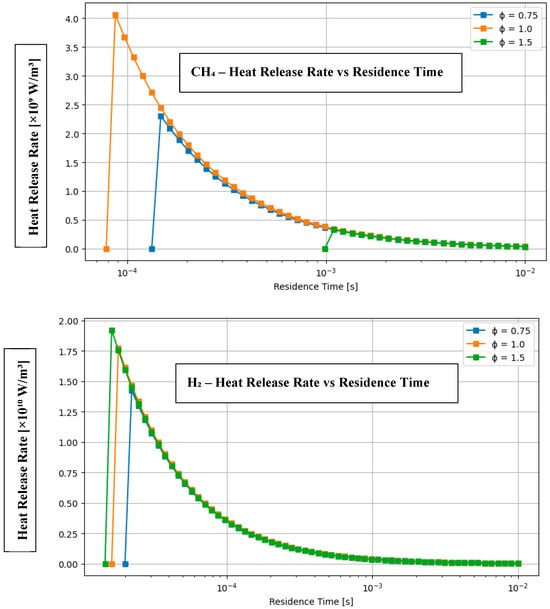
Figure 4.
Comparison of heat release against residence time for hydrogen and methane.
4.2. A Sensitivity Analysis of the System Involving a Blend of Hand Methanol, Focusing on Fuel Percentages and Equivalence Ratios
Figure 5 illustrates the combustion characteristics of hydrogen–methanol fuel mixtures evaluated at various equivalence ratios (ϕ = 0.75, 1.0, and 1.5), revealing notable variations in temperature increase and ignition properties. The graphs indicate that augmenting the hydrogen component (from 10% to 50% by mole) in methanol blends significantly increases the flame temperature, especially at reduced residence times. This is due to hydrogen’s elevated reactivity and combustion velocity, which facilitate swifter ignition and enhanced combustion efficiency. Under lean conditions (ϕ = 0.75), combustion persists, but with reduced peak temperatures; still, the inclusion of hydrogen mitigates the slower kinetics of methanol. Under stoichiometric and rich conditions (ϕ = 1.0 and 1.5), the temperature increases more rapidly and stabilizes more quickly, signifying effective combustion. These findings highlight hydrogen’s role in improving the thermal performance and ignition reliability of low-carbon methanol fuels, positioning it as a viable approach for cleaner, high-efficiency internal combustion systems and transition fuels for decarbonization.
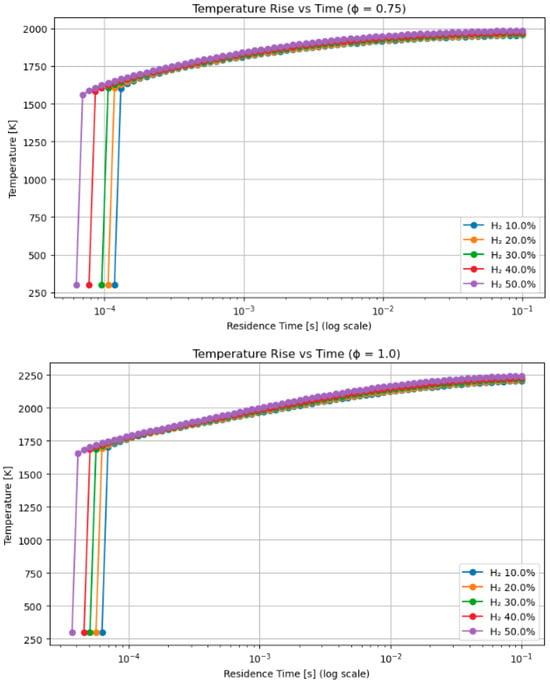
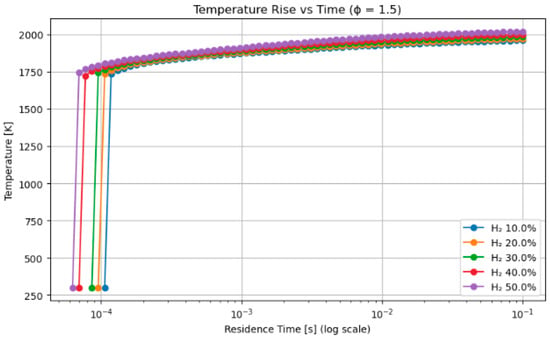
Figure 5.
Temperature increases for hydrogen–methanol mixture combustion under different equivalence ratios. Φ = 0.75: Slow ignition; high H2 needed to trigger rise. Φ = 1.0: Moderate ignition; responds well to H2. Φ = 1.5: Fast ignition; all blends ignite quickly.
Figure 6 illustrates that the combustion properties of hydrogen–methanol fuel blends exhibit unique thermochemical behavior, influenced by the equivalence ratio and hydrogen concentration. In mixes with hydrogen added on a molar (volume) basis—ranging from 10% to 50%—the total heat released becomes progressively more hostile, signifying enhanced exothermic combustion with increased hydrogen concentration. This pattern is particularly evident under stoichiometric conditions (ϕ = 1.0), where THE heat release attains its maximum intensity, indicating ideal energy production. The negative indication shows that heat is expelled from the system. At ϕ = 1.0, the fuel and oxidizer are equilibrated for optimal combustion, hence maximizing thermal efficiency. Lean mixtures (ϕ = 0.75) produce less total heat due to the restricted availability of fuel. In contrast, rich mixtures (ϕ = 1.5) exhibit a little lower heat release relative to stoichiometric conditions, owing to incomplete combustion resulting from oxygen deficiency. This analysis indicates that the maximum heat release occurs at stoichiometric conditions.
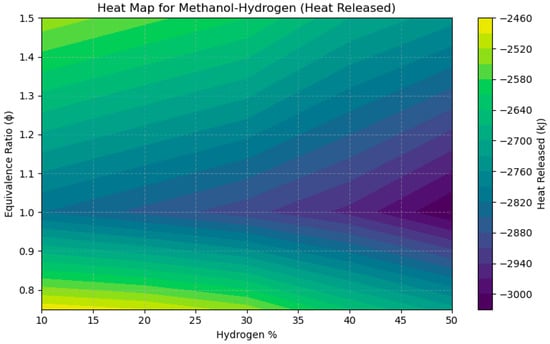
Figure 6.
Combustion heat release of methanol–hydrogen mixture.
Figure 7 illustrates that the NOx emission characteristics of methanol–hydrogen blends fluctuate considerably with respect to both the equivalence ratio (ϕ) and hydrogen concentration. The heat map indicates that NOx formation reaches its zenith near stoichiometric conditions (ϕ = 1.0), when flame temperatures are maximized, hence facilitating thermal NOx production through the Zeldovich mechanism. As the hydrogen volume fraction increases from 10% to 50%, NOx emissions rise, especially at ϕ = 1.0, due to hydrogen’s elevated adiabatic flame temperature and accelerated combustion kinetics. In lean mixtures (ϕ < 1), NOx generation significantly decreases due to lower temperatures and increased oxygen, whereas rich mixtures (ϕ > 1) also show diminished NOx levels as oxygen becomes a limiting reactant, despite elevated local temperatures. This pattern underscores the crucial influence of combustion temperature and local equivalency on NOx generation while also illustrating the compromise between improved thermal efficiency and pollution management when utilizing hydrogen-enriched low-carbon fuels.

Figure 7.
NOx emissions for hydrogen-enriched methanol.
4.3. A Sensitivity Analysis of the System Involving a Blend of Hydrogen and Methane, Focusing on Fuel Percentages and Equivalence Ratios
Figure 8 depicts the temperature progression during hydrogen–methane combustion at different hydrogen volume fractions (10–50%) and equivalence ratios (ϕ = 0.75, 1.0, 1.5). For all ϕ values, an increase in the hydrogen concentration reliably enhances the ignition speed and raises peak flame temperatures, attributable to hydrogen’s high reactivity and low ignition energy. At ϕ = 1.0 (stoichiometric), the mixture demonstrates the maximum overall temperature increase, underscoring the ideal equilibrium between fuel and oxidizer availability. Lean conditions (ϕ = 0.75) yield diminished flame temperatures, whereas rich conditions (ϕ = 1.5) similarly exhibit lowered temperatures due to restricted oxygen availability; nonetheless, ignition remains swift with elevated hydrogen concentrations. The curves validate hydrogen’s significant enhancing influence on combustion kinetics and thermal output, indicating its potential to augment efficiency and ignition stability in methane-fueled systems.
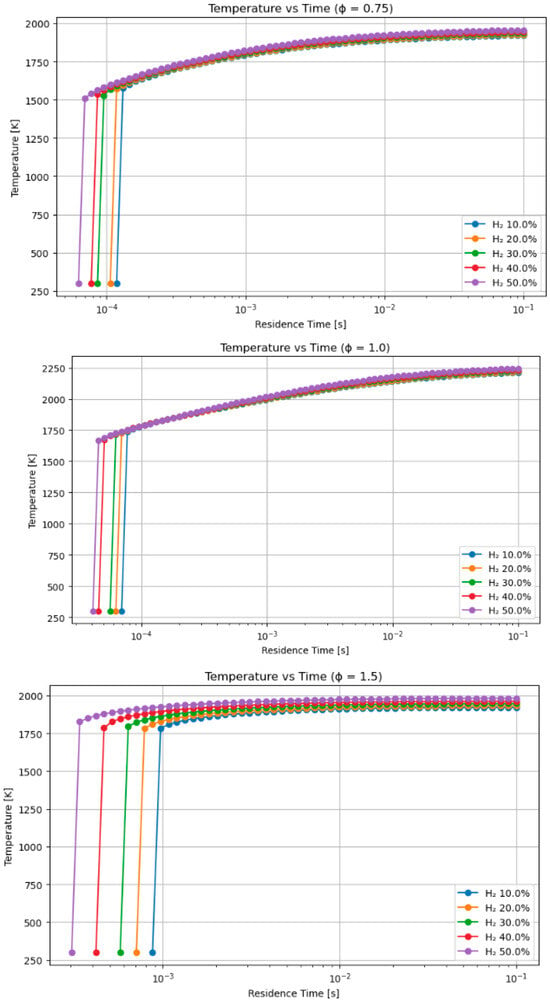
Figure 8.
Temperature increases for hydrogen–methane mixture combustion under different equivalency ratios. Φ = 0.75: Slow ignition, needs longer time and more H2, ϕ = 1.0: Moderate ignition delay, responds well to H2, ϕ = 1.5: Fast ignition, even low H2 ignites quickly.
Figure 9 depicts the total heat emitted during the combustion of methane–hydrogen blends correlating with the hydrogen volume percentage (10–50%) and equivalence ratio (ϕ = 0.75–1.5). The heat values are presented as unfavorable, signifying exothermic energy release. The more negative the value, the greater the heat released during combustion. Under stoichiometric conditions (ϕ = 1.0), combustion exhibits the most significant negative heat release values, indicating that the ideal air–fuel ratio yields the most excellent thermal output. As the hydrogen percentage increases, the total heat released becomes more negative, indicating an increase in combustion energy due to hydrogen’s higher lower heating value (LHV = 120 MJ/kg) and greater reactivity. In lean combinations (ϕ < 1), the heat output diminishes significantly due to additional air diluting the flame, whereas rich mixtures (ϕ > 1) exhibit heightened heat release due to higher fuel availability, potentially compromising efficiency. These findings highlight that hydrogen enrichment in methane-fueled systems significantly enhances thermal performance, particularly under stoichiometric and rich conditions.

Figure 9.
Heat emitted from methane-enriched hydrogen mixture.
Figure 10 illustrates a heat map that displays the range of NOx emissions (in ppm) generated by methane–hydrogen combustion across different hydrogen concentrations and equivalency ratios. The statistics indicate that NOx generation is significantly influenced by fuel composition and combustion circumstances. Peak NOx concentrations occur at stoichiometric equivalency ratios, characterized by heightened combustion temperatures and reaction rates. As the hydrogen proportion increases, especially beyond 30–35%, NOx emissions significantly rise under near-stoichiometric conditions. Conversely, both lean and rich combustion regimes are correlated with diminished NOx emissions, which are attributed to lower flame temperatures and modified reaction kinetics. This image highlights the importance of meticulously regulating hydrogen blending ratios and operational parameters to mitigate NOx emissions in hydrogen-enriched gas turbine systems.
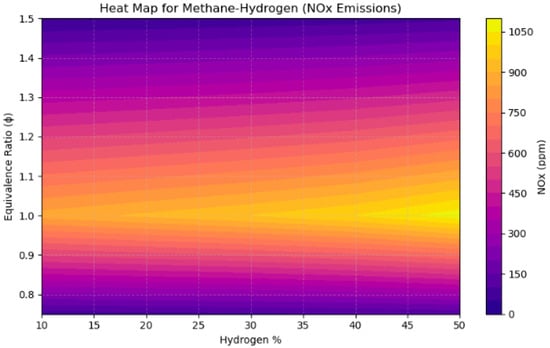
Figure 10.
NOx emissions heat map for methane–hydrogen blends as a function of hydrogen content and equivalence ratio.
Figure 11 displays a heat map illustrating the fluctuation in CO2 emissions (in ppm) resulting from methane–hydrogen combustion across various hydrogen blending ratios and equivalence ratios. The graphic illustrates a steady decline in CO2 emissions as the hydrogen concentration increases across all equivalence ratios, primarily due to the carbon-free characteristics of hydrogen fuel. Peak CO2 concentrations are detected in proximity to the stoichiometric area, when combustion efficiency and flame temperatures are generally optimized. As the hydrogen proportion rises, the total carbon contribution from the fuel mixture diminishes, resulting in a concomitant decrease in CO2 emissions. Furthermore, reduced emissions are observed under affluent conditions, attributed to incomplete combustion and limited oxygen availability. This trend validates the efficacy of hydrogen substitution in reducing carbon emissions in methane-fueled combustion systems, underscoring its significance in the decarbonization of gas turbine applications.
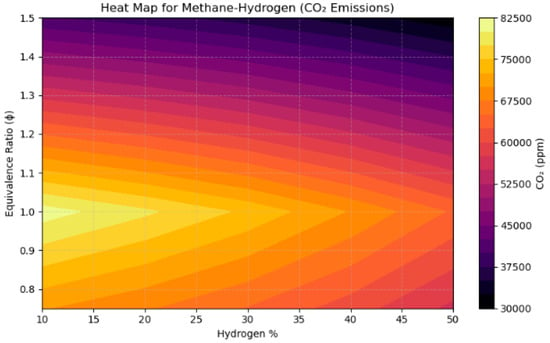
Figure 11.
CO2 emissions heat map for methane–hydrogen blends as a function of hydrogen content and equivalence ratio.
4.4. A Sensitivity Analysis of the System Involving a Blend of Hydrogen and Propane, Focusing on Fuel Percentages and Equivalence Ratios
Figure 12 illustrates the temperature progression of propane–hydrogen–air mixtures relative to the residence time for the equivalence ratios (ϕ = 0.75, 1.0, and 1.5). In all three circumstances, ignition behavior is defined by a rapid temperature increase occurring within a brief residence time interval, usually between 10−4 and 10−2 seconds. This abrupt escalation signifies a short ignition delay succeeded by a swift heat release. As the hydrogen concentration increases from 10% to 50% in the fuel mixture, a significant improvement in ignition timing is evident, particularly under stoichiometric (ϕ = 1.0) and lean (ϕ = 0.75) conditions. This transition indicates hydrogen’s superior reactivity and accelerated radical generation compared to propane, resulting in a shorter ignition delay. In rich mixtures (ϕ = 1.5), the curves converge more closely, signifying a diminished sensitivity of ignition delay to hydrogen fraction, probably due to enhanced fuel dilution and restricted oxidizer availability. Significantly, despite the differing hydrogen content, the ultimate temperatures generally align for each ϕ, indicating that the adiabatic flame temperature is predominantly influenced by the equivalency ratio rather than the precise fuel composition. These findings underscore the preeminent influence of hydrogen on ignition time, but propane plays a substantial role in the overall energy output and flame temperature. Integrating hydrogen into propane combustion mixtures significantly improves ignition performance, especially under lean and stoichiometric conditions.
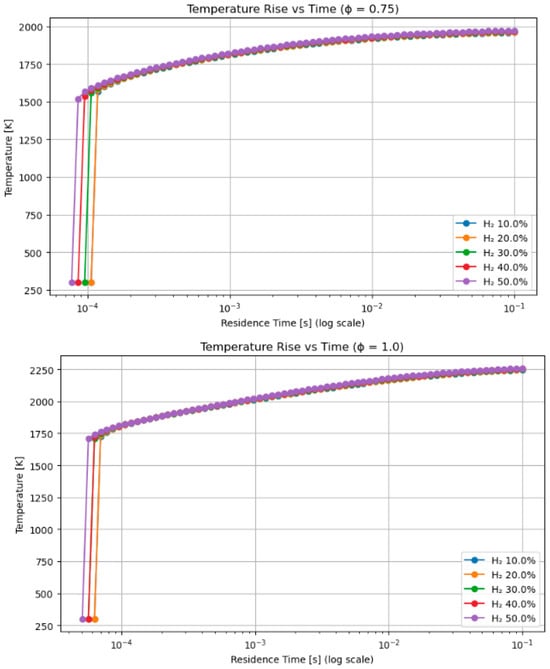
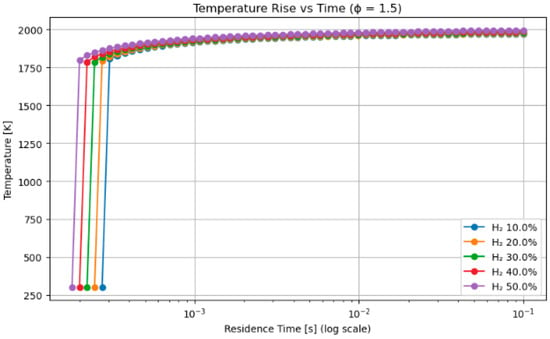
Figure 12.
Temperature increases for hydrogen–propane mixture combustion under different equivalency ratios.
The heat map of NOx emissions in Figure 13 for propane–hydrogen mixtures exhibits a pronounced peak situated at stoichiometric circumstances (ϕ ≈ 1.0) and elevated hydrogen fractions (≥40%). The generation of NOx escalates significantly with higher hydrogen content, attributed to increased flame temperatures and accelerated reaction kinetics that promote thermal NO processes. In contrast, both lean (ϕ < 0.9) and rich (ϕ > 1.3) mixtures inhibit NOx production, mostly due to reduced flame temperatures and restricted oxygen availability or complete combustion, respectively. This non-linear pattern underscores the significant interrelationship among hydrogen enrichment, combustion temperature, and oxidizer availability in regulating NOx generation in blended fuels.
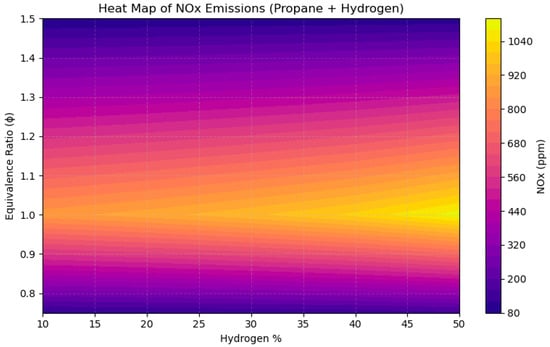
Figure 13.
Heat emitted from propane-enriched hydrogen mixture.
Figure 14’s heat map of total heat released for propane–hydrogen mixes indicates a distinct maximum under stoichiometric circumstances (ϕ ≈ 1.0) and elevated hydrogen concentration. As the amount of hydrogen grows, the total heat release escalates due to hydrogen’s superior specific energy and accelerated combustion kinetics, hence augmenting the overall exothermicity of the reaction. Rich mixtures (ϕ > 1.2) and lean mixtures (ϕ < 0.9) demonstrate diminished heat release, indicative of incomplete combustion or excessive dilution effects. This behavior demonstrates that stoichiometry and hydrogen enrichment are essential for optimizing combustion efficiency and energy output in dual-fuel systems.
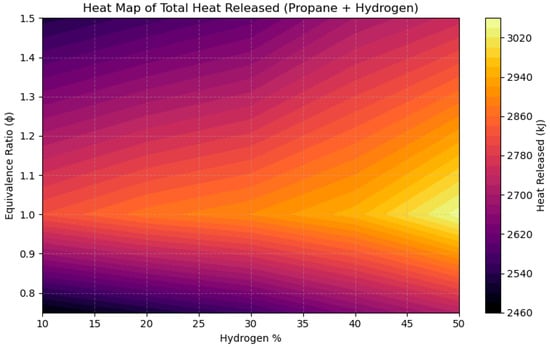
Figure 14.
Combustion heat release of propane–hydrogen mixture.
4.5. Ignition Delay for Different Fuels Compared to Hydrogen
Figure 15 illustrates the ignition delay times of various fuels, including hydrogen, methane, methanol, propane, and ethylene, as a function of temperature. Hydrogen has the shortest delay, indicating its higher reactivity and lower activation energy, resulting in faster flame propagation and improved combustion efficiency. Methane exhibits a longer delay, particularly at lower temperatures, suggesting slower reaction rates and higher energy thresholds. Propane and ethylene exhibit intermediate behaviors, with their delays decreasing more steeply as temperatures rise. Methanol, closer to propane and ethylene, still lags behind hydrogen in terms of reactivity. This suggests that hydrogen is suitable for high-efficiency combustion systems.

Figure 15.
Different fuels’ ignition delays.
4.6. Influence of Ignition Technique and Residence Duration on Ultimate Flame Temperature and NOx in Hydrogen-Enriched Methane Blends
Figure 16 analyzes the final combustion temperatures of hydrogen-enriched CH4–air mixtures under spark ignition across different residence times, using the adiabatic equilibrium as a reference point. At 1 ms, successful ignition occurs along with high hydrogen content and increased spark temperatures. With an increase in residence time, even low-energy sparks facilitate near-complete combustion, resulting in the final temperatures nearing equilibrium levels at 5 ms. The findings indicate that, although spark ignition is highly contingent on the initial heat input, extending the residence time markedly improves ignition reliability and energy output, thereby reducing the disparity with optimal equilibrium performance.

Figure 16.
Final temperature vs. hydrogen percent for spark-ignited combustion at 1 ms, 3 ms, and 5 ms compared to adiabatic equilibrium. (Top plot) (1 ms): Only high H2 (>45%) and high spark temperature (1300–1400 K) give a large temperature rise. (Middle plot) (3 ms): Moderate H2 (~35%) with higher spark temps shows strong rise; matches equilibrium above 40%. (Bottom plot) (5 ms): Even at 30% H2, final temperature reaches near equilibrium for all spark temperatures.
Figure 17 demonstrates the trends in NOx emissions and shows a significant correlation with the residence duration and ignition temperature in hydrogen-enriched CH4–air mixtures. At 1 ms, NOx generation is negligible, except at the most excellent spark temperature (1200 K) with 50% H2, where ignition transpires. With an increase in residence time to 3 ms and 5 ms, combustion achieves more completeness, particularly at moderate spark temperatures and hydrogen concentrations, resulting in markedly elevated NOx emissions. At 5 ms, NOx generation surpasses equilibrium levels in numerous instances, influenced by extended exposure to elevated post-flame temperatures. These results highlight the trade-off between enhancing ignition and reducing NOx when determining the spark energy and residence time in advanced combustion techniques.
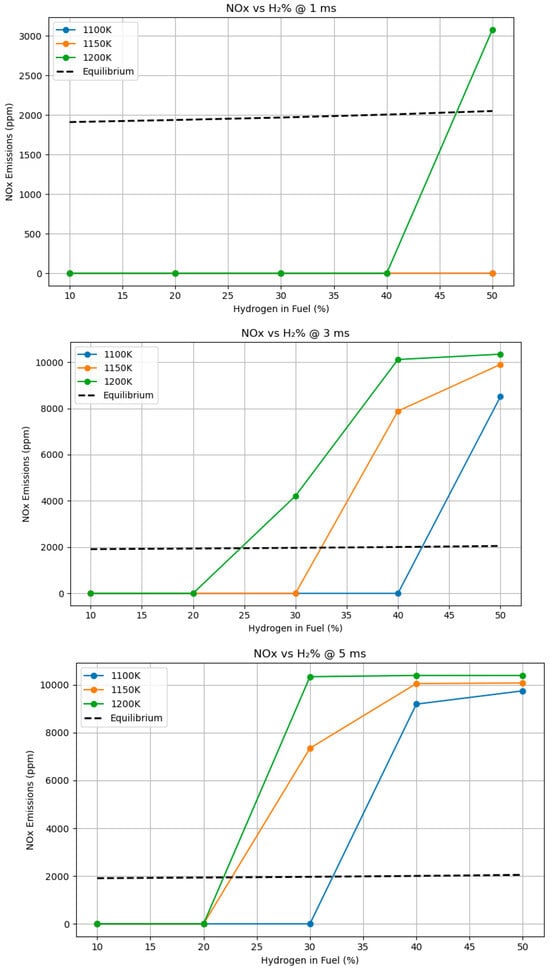
Figure 17.
NOx emissions vs. hydrogen percentage for spark-ignited CH4-H2 mixtures at varying residence times.
5. Validation and Practical Implications for Engine Design
The subsequent Table 1 delineates a thermodynamic methodology for calculating the heat emitted per cubic meter of a stoichiometric air–fuel mixture of hydrogen combined with several standard fuels (methanol, methane, and propane). This methodology adheres to classical chemical thermodynamics by computing the stoichiometric oxygen demand, incorporating the requisite nitrogen from air, ascertaining the total moles in the reactant mixture, and employing the fuel mole fraction alongside molar heating values (HHV) to approximate the total energy release per unit volume. The calculated values are subsequently compared to comprehensive results from Cantera simulations, which numerically determine the equilibrium state of the combustion mixture utilizing integrated thermochemical data and reaction mechanisms.

Table 1.
Incremental thermodynamic calculation of heat released per cubic meter for a stoichiometric H2–CH3OH mixture (ϕ = 1.0).
This comparison underscores the concordance between the thermodynamic approximation and Cantera’s heat release model under stoichiometric conditions. The discrepancies between the techniques are mainly due to the ideal gas assumptions and the static higher heating value employed in the thermodynamic model, in contrast to the dynamic enthalpy-based calculations in Cantera, which account for equilibrium product composition and species-specific heat capacity.
The Cantera-based combustion simulations were validated against classical thermodynamic calculations under stoichiometric conditions Figure 18. The thermodynamic approach, based on ideal gas assumptions and standard higher heating values (HHVs), provides a transparent and widely accepted reference for estimating heat release. By calculating the energy per unit volume from known fuel compositions, oxygen requirements, and HHVs, the thermodynamic model establishes a dependable benchmark rooted in fundamental energy conservation principles.
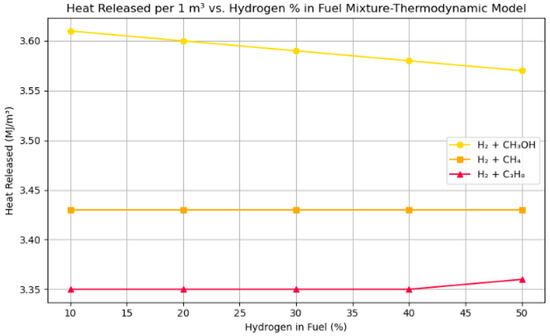
Figure 18.
Thermodynamic calculation of heat released per cubic meter for a stoichiometric propane-, methane-, and methanol–hydrogen-enriched mixture.
When compared to this benchmark, Cantera results showed close agreement in both trend and magnitude Table 2, confirming the physical consistency of its combustion heat predictions. Minor deviations were observed, which are attributable to Cantera’s detailed treatment of equilibrium product species, partial dissociation, and variable thermodynamic properties—effects inherently neglected in the simplified thermodynamic framework.

Table 2.
Heat released at stoichiometric combustion (ϕ = 1.0): comparison between Cantera model and thermodynamic model.
Literature Validation
Jingyun Sun’s (2023) [9] study on hydrogen–methanol blends with varying methane percentages aligns with Sun et al.’s (2023) study on pollutant formation mechanisms in hydrogen–ammonia–methanol ternary carbon-neutral fuel blend combustion. Both studies highlight the dual role of hydrogen and methanol in influencing NOx emissions and combustion dynamics. Higher hydrogen fractions lead to elevated NOx emissions due to increased flame temperatures.
A study by Dimitriou, 2018 [11], on a multi-cylinder compression ignition engine found that it can reduce harmful emissions b up to 90% at low load conditions. However, the maximum H2 energy share ratio drops to 85% at medium loads, leading to unbalanced operation. High in-cylinder temperatures increase NOx emissions by up to four times compared to conventional engines. Exhaust gas recirculation reduces NOx emissions by up to 75%, which is in line with the current results.
Li’s (2023) [33] study confirms the strong correlation between flame temperature and NOx emissions, highlighting the role of high temperatures in thermal NOx formation. It also demonstrates that adjusting hydrogen equivalence ratios effectively controls NOx emissions, emphasizing the importance of equivalence ratio management.
Q.T. Dam’s (2024) [13] paper presents a dynamic model for an internal combustion engine powered by hydrogen, focusing on engine efficiency, torque, and emission reductions. The model shows high efficiency in hydrogen combustion, but high combustion temperatures necessitate effective cooling systems, which is identical to our current numerical results.
The findings from Verhelst, 2023 [14], and Wallnerb, 2009 [15] regarding hydrogen–methane mixes corroborate and enhance our results by illustrating the trade-offs among NOx emissions, energy density, and engine efficiency. Our findings demonstrate that hydrogen-rich blends produce more significant NOx emissions, owing to increased flame temperatures, aligning with this study’s observation that higher methane concentrations diminish NOx emissions by tempering flame temperatures. The reduction in engine performance with an elevated methane percentage corresponds with our observations that hydrogen’s better mass-based energy density improves thermal efficiency, especially at low equivalency ratios.
S. Molina’s (2023) [16] study supports our investigation into the feasibility of hydrogen as a fuel and how it interacts with dilution techniques for NOx reduction. Our results show comparable trade-offs when blending hydrogen with methanol and methane, highlighting the significance of regulating dilution rates to balance thermal efficiency and combustion stability.
Experiments (S.K.V, 2014) [17] demonstrate that, because of improved combustion properties, adding hydrogen to fuel mixes increases brake thermal efficiency and lowers CO and HC emissions. Both also note that, particularly at larger hydrogen fractions, the high flame temperature of hydrogen causes a rise in NOx emissions. Additionally, both studies highlight how performance can be maintained and emission trade-offs minimized by blending hydrogen in controlled proportions, such as up to 20%.
M. Huang’s (2024) [18] study investigates the impact of injector design and timing on hydrogen combustion in internal combustion engines. It reveals that larger injectors increase fuel delivery but increase pre-ignition risk. Early injection improves stability, while late injection reduces NOx emissions but increases knock risk. Optimized injector configurations improve engine efficiency and reduce NOx emissions, which is complementary to our numerical model results of proper injection percentages.
R.A. Bakar’s (2022) [19], examines the efficacy of a direct injection diesel engine utilizing hydrogen in a dual-fuel configuration. Essential findings encompass the assessment of hydrogen flow rates, engine efficiency, NOx emissions, and combustion stability. Both studies forecast a 15–20% enhancement in efficiency, attributable to hydrogen’s superior flame velocity and reduced ignition energy. Both emphasize the difficulty of regulating NOx emissions, with the experimental study revealing no substantial decrease in NOx despite augmented hydrogen flow, but CO, CO2, and particulate emissions were markedly diminished.
Practical implications for engine design: This study’s findings have considerable consequences for engine design, especially in areas where hydrogen is scarce but methanol is more readily available. In these situations, incorporating even minimal amounts of hydrogen into the combustion process can improve the combustion efficiency of methanol, utilizing hydrogen’s quick ignition and flame propagation characteristics. This synergy enhances energy conversion and lowers CO emissions, as hydrogen promotes more thorough oxidation of methanol under lean conditions.
Moreover, the amalgamation of methanol and hydrogen tackles significant emissions issues. The cooling properties of methanol mitigate the elevated flame temperatures associated with hydrogen, thereby effectively reducing NOx emissions. This renders the blend especially advantageous in regions with tight NOx limits. Moreover, hydrogen supplementation enables the more efficient use of methanol as a primary fuel, thereby facilitating engine operation with reduced environmental impact and improved energy efficiency.
By strategically integrating hydrogen, even in small quantities, with methanol, engine designs can achieve a cleaner and more efficient combustion process, making this method feasible for remote or infrastructure-limited areas. This combination enables adaptable, multi-fuel systems that can respond to varying fuel supplies while ensuring optimal performance and regulatory compliance.
6. Conclusions
- This study illustrates, via Cantera-based PSR simulations and thermodynamic validation, the crucial significance of hydrogen enrichment in improving combustion performance and informing fuel-flexible engine strategies. The analysis of the combustion of hydrogen, methane, methanol, and propane at different equivalence ratios (ϕ = 0.75, 1.0, 1.5) and hydrogen blending levels (10–50% by mole) reveals numerous significant findings as follows:
- Hydrogen consistently elevates peak flame temperature, achieving up to 2350 K for H2-rich mixes, in contrast to 2100–2200 K for pure methane or methanol under stoichiometric conditions.
- The heat emission per unit volume reaches its maximum at ϕ = 1.0 for all fuels. A 30% H2–70% CH3OH mixture demonstrates a thermodynamic heat release of 3.59 MJ/m3, whereas Cantera forecasts 2.82–3.00 MJ, validating the consistency in both magnitude and trend.
- Hydrogen–methanol and hydrogen–methane mixtures exhibited ignition onset up to 30% faster at short residence durations (≤1 ms), highlighting its appropriateness for pre-chamber and rapid ignition combustion systems.
- NOx emissions reached their zenith near stoichiometric circumstances (ϕ = 1.0), with concentrations increasing by over 200 ppm when hydrogen content surpassed 40% in CH4 and CH3OH mixtures, attributable to heightened flame temperatures.
- CO2 emissions diminished linearly with the incorporation of hydrogen, decreasing by more than 40% as the hydrogen proportion escalated from 10% to 50% in CH4-based fuels, thus illustrating hydrogen’s capacity for decarbonization.
- The thermodynamic model, grounded in stoichiometric combustion analysis and higher heating values, precisely aligns with Cantera’s predictions for heat release. Thermodynamic estimations of 3.61 MJ/m3 for H2–CH3OH and 3.35 MJ/m3 for H2–C3H8 closely correspond with Cantera values of 2.82–3.02 MJ, hence confirming Cantera’s trustworthiness in equilibrium combustion modeling. Discrepancies of 10–15% arise from Cantera’s incorporation of real-gas effects, product dissociation, and enthalpy variations—elements not accounted for in idealized HHV-based computations.
- These findings affirm Cantera as a precise and physically coherent instrument for simulating hydrogen-enriched combustion systems, emphasizing the substantial impact of fuel mixture, equivalency ratio, and residence time on thermal performance and emissions. This research guides the design of hydrogen-integrated spark-ignition and pre-chamber engines by determining the ideal fuel blends and operating conditions that achieve great thermal efficiency while minimizing carbon and NOx emissions.
- This study integrates validated kinetic modeling with thermodynamic analysis to facilitate the advancement of cleaner, high-efficiency internal combustion technologies, providing practical guidance for fuel formulation, combustion chamber design, and emission control in relation to hydrogen co-firing and alternative fuel approaches.
Novelty and Engine Application
The originality of this study lies in its comprehensive methodology for modeling and testing hydrogen-enriched combustion, which utilizes detailed chemical kinetics (using Cantera) and traditional thermodynamic techniques. This study carefully examines hydrogen blending with various conventional fuels—methanol, methane, and propane—across a range of equivalency ratios and residence times, in contrast to prior research that often emphasizes single-fuel behavior. It provides a comprehensive comparison framework that elucidates the dynamic interplay of fuel mix, combustion efficiency, and emissions. This methodology validates Cantera’s forecast accuracy through stringent thermodynamic benchmarking and connects simulation insights with real-world engine applications. The findings are particularly relevant to contemporary internal combustion engines, notably those with pre-chamber and stratified-charge configurations, where regulating ignition timing, thermal output, and emission production is essential. The model provides recommendations for optimal hydrogen blending ratios (30–50%) and residence times (1–5 ms) to achieve enhanced thermal efficiency while reducing NOx and CO2 emissions, thereby facilitating cleaner, quicker, and more reliable ignition strategies for advanced hydrogen-integrated propulsion systems.
Funding
This research received no external funding.
Institutional Review Board Statement
Ethical review and approval were not required as the study did not involve human or animal subjects.
Informed Consent Statement
Not applicable.
Data Availability Statement
The Python v3 code used in this study is available upon request.
Conflicts of Interest
The author declares no conflict of interest.
References
- Krebs, S.; Biet, C. Predictive model of a premixed, lean hydrogen combustion for internal combustion engines. Transp. Eng. 2021, 5, 100086. [Google Scholar] [CrossRef]
- College of the Desert. Hydrogen Fuel Cell Engines and Related Technologies; Dempsey, J., Ed.; Revision 0; Energy Technology Training Center, College of the Desert: Palm Desert, CA, USA, 2001. [Google Scholar]
- Dhar, P.S. Compression ratio influence on combustion and emissions characteristic of hydrogen-diesel dual-fuel CI engine: Numerical study. Fuel 2018, 222, 852–858. [Google Scholar] [CrossRef]
- Efstathios, A.T. Hydrogen for Future Thermal Engines; Springer: Berlin/Heidelberg, Germany, 2023. [Google Scholar]
- Homan, H.; Reynolds, R.; Deboer, P.; McLean, W. Hydrogen-fueled diesel engine without timed ignition. Int. J. Hydrogen Energy 1979, 4, 315–325. [Google Scholar] [CrossRef]
- Lee, K.J.; Kim, Y.R.; Byun, C.H.; Lee, J.T. Feasibility of compression ignition for hydrogen-fueled engine with neat hydrogen-air pre-mixture by using high compression. Int. J. Hydrogen Energy 2013, 38, 255–264. [Google Scholar] [CrossRef]
- Sandalcı, T.; Karagöz, Y. Experimental investigation of the combustion characteristics, emissions, and performance of hydrogen port fuel injection in a diesel engine. Int. J. Hydrogen Energy 2014, 39, 18480–18489. [Google Scholar] [CrossRef]
- Tsujimura, Y.S. The Combustion Improvements of Hydrogen/Diesel Dual Fuel Engine; SAE Technical Paper; SAE International: Warrendale, PA, USA, 2015. [Google Scholar] [CrossRef]
- Sun, J.; Liu, Q.; Wang, Y.; Gu, M.; Huang, X. Reactive Molecular Dynamics Study of Pollutant Formation Mechanism in Hydrogen/Ammonia/Methanol Ternary Carbon-Neutral Fuel Blend Combustion. Molecules 2023, 28, 8140. [Google Scholar] [CrossRef]
- Dimitriou, P.; Tsujimura, T. A review of hydrogen as a compression ignition engine fuel. Int. J. Hydrogen Energy 2017, 42, 24470–24486. [Google Scholar] [CrossRef]
- Dimitriou, P.; Kumar, M.; Tsujimura, T.; Suzuki, Y. Combustion and emission characteristics of a hydrogen-diesel dual-fuel engine. Int. J. Hydrogen Energy 2018, 43, 13605–13617. [Google Scholar] [CrossRef]
- Luo, Q.-H.; Hu, J.-B.; Sun, B.-G.; Liu, F.-S.; Wang, X.; Li, C.; Bao, L.-Z. Effect of equivalence ratios on the power, combustion stability and NOx controlling strategy for the turbocharged hydrogen engine at low engine speeds. Int. J. Hydrogen Energy 2019, 44, 17095–17102. [Google Scholar] [CrossRef]
- Dam, Q.T. Modeling and simulation of an internal combustion engine using hydrogen: A MATLAB implementation approach. Eng. Perspect. 2024, 3, 108–118. [Google Scholar] [CrossRef]
- Verhelst, Y.W. Comparative analysis and optimization of hydrogen combustion mechanism for laminar burning velocity calculation in combustion engine modelling. Int. J. Hydrogen Energy 2023, 48, 112–125. [Google Scholar] [CrossRef]
- Wallnerb, S.V. Hydrogen-Fueled Internal Combustion Engines. Prog. Energy Combust. Sci. 2009, 35, 490–527. [Google Scholar]
- Molina, S.; Novella, R.; Gomez-Soriano, J.; Olcina-Girona, M. Experimental activities on a hydrogen-fueled spark-ignition engine for light-duty applications. Appl. Sci. 2023, 13, 12055. [Google Scholar] [CrossRef]
- Shivaprasad, K.V.; Raviteja, S.; Chitragar, P.; Kumar, G.N. Experimental Investigation of the Effect of Hydrogen Addition on Combustion Performance and Emissions Characteristics of a Spark Ignition High-Speed Gasoline Engine. Procedia Technol. 2014, 14, 141–148. [Google Scholar] [CrossRef]
- Huang, Q.L. Experimental investigations of the hydrogen injectors on the combustion characteristics and performance of a hydrogen internal combustion engine. Sustainability 2024, 16, 1940. [Google Scholar] [CrossRef]
- Bakar, R.A.; Widudo; Kadirgama, K.; Ramasamy, D.; Yusaf, T.; Kamarulzaman, M.K.; Sivaraos; Aslfattahi, N.; Samylingam, L.; Alwayzy, S.H. Experimental analysis on the performance, combustion/emission characteristics of a DI diesel engine using hydrogen in dual fuel mode. Int. J. Hydrogen Energy 2022, 52, 843–860. [Google Scholar] [CrossRef]
- Keromnes, W.K.-J. An experimental and detailed chemical kinetics model for hydrogen-methane mixture oxidation at elevated pressures. Combust. Flame 2013, 160, 995–1011. [Google Scholar] [CrossRef]
- Stoke, W.H. Hydrogen-Cum-Oil Gas as an Auxiliary Fuel for Airship Compression Ignition Engines; Report No. E 3219; British Royal Aircraft Establishment: Farnborough, UK, 1930. [Google Scholar]
- Chintala, V.; Subramanian, K. Hydrogen energy share improvement along with NOx (oxides of nitrogen) emission reduction in a hydrogen dual-fuel compression ignition engine using water injection. Energy Convers. Manag. 2014, 83, 249–259. [Google Scholar] [CrossRef]
- Tsujimura, T.; Suzuki, Y. The utilization of hydrogen in a hydrogen/diesel dual-fuel engine. Int. J. Hydrogen Energy 2017, 42, 24470–24486. [Google Scholar] [CrossRef]
- Tsujimura, M.D. A fully renewable and efficient backup power system with a hydrogen-biodiesel-fueled IC engine. Energy Procedia 2019, 157, 1305–1319. [Google Scholar] [CrossRef]
- David, G.; Goodwin, H.K. Cantera: An object-oriented software toolkit for chemical kinetics, thermodynamics, and transport processes. Version 3.0.0. 2023. Available online: https://www.cantera.org (accessed on 1 October 2024).
- Shahpouri, S.; Gordon, D.; Hayduk, C.; Rezaei, R.; Koch, C.R.; Shahbakhti, M. Hybrid emission and combustion modeling of hydrogen-fueled engines. Int. J. Hydrogen Energy 2023, 48, 24037–24053. [Google Scholar] [CrossRef]
- Rosati, M.F.; Aleiferis, P.G. Hydrogen SI and HCCI combustion in a direct-injection optical engine. SAE Int. J. Engines 2009, 2, 1710–1736. [Google Scholar] [CrossRef]
- Ikegami, K.M. A study on hydrogen-fuelled diesel combustion (1st report). Prepr. Jpn. Soc. Mech. Eng. 1975, 750, 239–242. [Google Scholar]
- Chaichan, M.T.; Al-Zubaidi, D.S.M. A practical study of using hydrogen in dual-fuel compression ignition engine. Int. Publ. Adv. Sci. J. (IPASJ) 2015, 2, 1–10. [Google Scholar]
- Saravanan, N.; Nagarajan, G. Experimental investigation on a DI dual fuel engine with hydrogen injection. Int. J. Energy Res. 2009, 33, 295–308. [Google Scholar] [CrossRef]
- Smirnov, N.; Nikitin, V. Modeling and simulation of hydrogen combustion in engines. Int. J. Hydrogen Energy 2014, 39, 1122–1136. [Google Scholar] [CrossRef]
- Yakovenko, I.; Kiverin, A. Numerical Modeling of Hydrogen Combustion: Approaches and Benchmarks. Fire 2023, 6, 239. [Google Scholar] [CrossRef]
- Li, C.; Wang, Y.; Jia, B.; Zhang, Z.; Roskilly, A. Numerical Investigation on NOx Emission of a Hydrogen-Fuelled Dual-Cylinder Free-Piston Engine. Appl. Sci. 2023, 13, 1410. [Google Scholar] [CrossRef]
Disclaimer/Publisher’s Note: The statements, opinions and data contained in all publications are solely those of the individual author(s) and contributor(s) and not of MDPI and/or the editor(s). MDPI and/or the editor(s) disclaim responsibility for any injury to people or property resulting from any ideas, methods, instructions or products referred to in the content. |
© 2025 by the author. Licensee MDPI, Basel, Switzerland. This article is an open access article distributed under the terms and conditions of the Creative Commons Attribution (CC BY) license (https://creativecommons.org/licenses/by/4.0/).